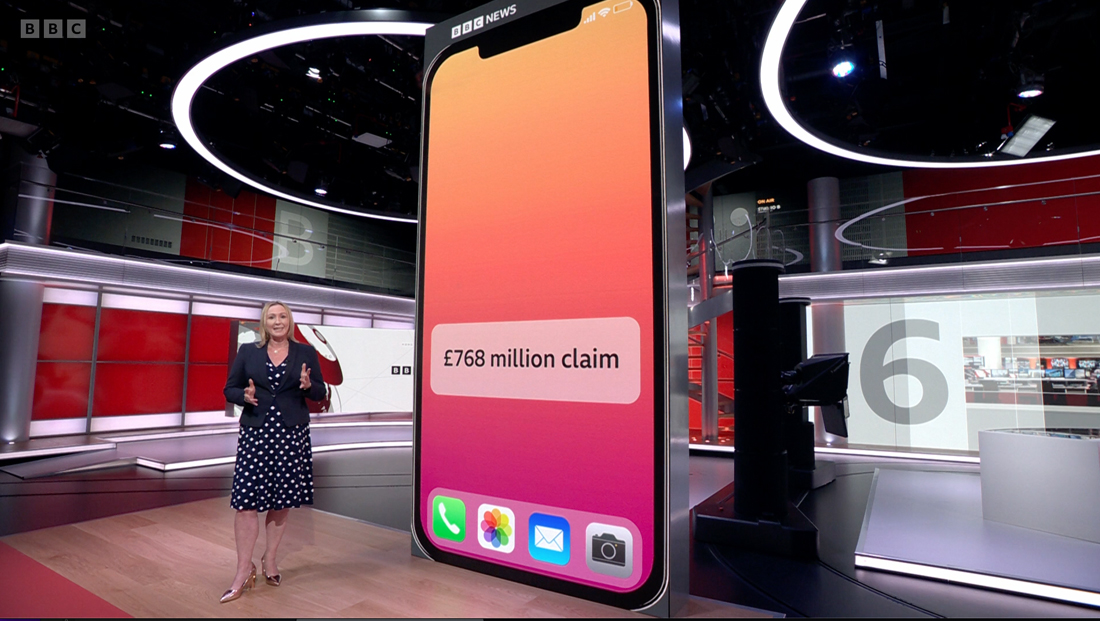BBC transforms video tower into giant iPhone

Subscribe to NCS for the latest news, project case studies and product announcements in broadcast technology, creative design and engineering delivered to your inbox.
BBC used one of the monolithic video towers in its recently overhauled Studio B to create the look of a giant iPhone.
The broadcaster, which debuted the new set June 13, 2022, was covering a British lawsuit filed June 16, 2022, about Apple’s alleged secret practice of slowing older model iPhones, presumably as a well to nudge users toward an upgrade.
During a previously released tour of the new studio, BBC anchor Huw Edwards noted that the freestanding Tower A in the middle of the new set mirrors the orientation and shape of a mobile device.
The 6 p.m. newscast June 16 took that interpretation a step farther and, after a brief appearance of BBC News-branded graphics, created the appearance of a giant iPhone in the middle of the studio.
In this case, the iPhone’s physical frame, as well as the on-screen interface, was included in the graphic.
The look simulated a device with a red-orange gradient background with four common iPhone app icons in the dock below, an instantly recognizable look for millions around the world.
As the presenter summarized the key facts of the lawsuit, a visual representation of low battery mode appeared on the video tower when it was mentioned, followed by rounded rectangles with key points in them, all presented in a style that mimics some of Apple’s design aesthetics.
By shooting the tower off-axis and using a rich black border but keeping the negative space outside of the rounded corners of the graphic as “dark” diodes, BBC was able to create a fairly convincing illusion of a giant iPhone with silver side (though this feature is not included in the latest model) standing in the middle of the studio.
Toward the end of the segment, the camera, powered by Electronic Friends’ track-mounted robotic pedestals, moved in for a tighter view, though the screen of the graphic did not feature any additional text.
Overall, that was the end of a segment that, despite the dramatic imagery, fell a bit flat in terms of the on-screen information presented — it was mostly simple text that had the feel that it was created quickly.
Text, at times, felt crammed into the boxes when it could have been illustrated broken up into multiple boxes or parts with the added advantage of allowing the text to be a bit larger.
Some of the text also remained on-screen for what seemed to be a rather lengthy amount of time when, perhaps, some additional animation or text could have been used to keep the segment’s visuals more fluid and dynamic.
Overall, the segment didn’t seem to specifically benefit from the giant iPhone graphic — it likely could have been done in a much simpler format with the same degree of effectiveness.
That said, the eye-catching look did have the advantage of being able to nearly instantly communicate the main idea of the story. The storytelling wasn’t exactly diminished, either, which would have encroached on the using the tower just for the sake of using it.
However, if BBC was looking to leverage its investment and grab eyeballs (nothing inherently wrong with that), it likely accomplished that.
Subscribe to NCS for the latest news, project case studies and product announcements in broadcast technology, creative design and engineering delivered to your inbox.



tags
BBC, BBC News, Electronic Friends, studio b
categories
Broadcast Design, Broadcast Industry News, Featured, Set Design, Video Walls